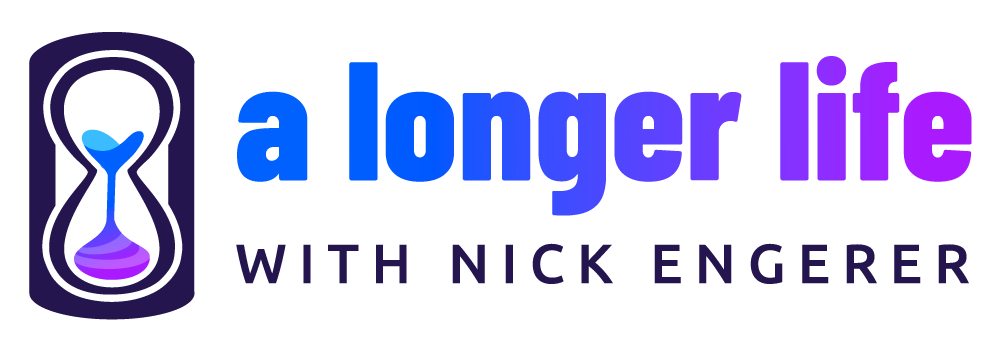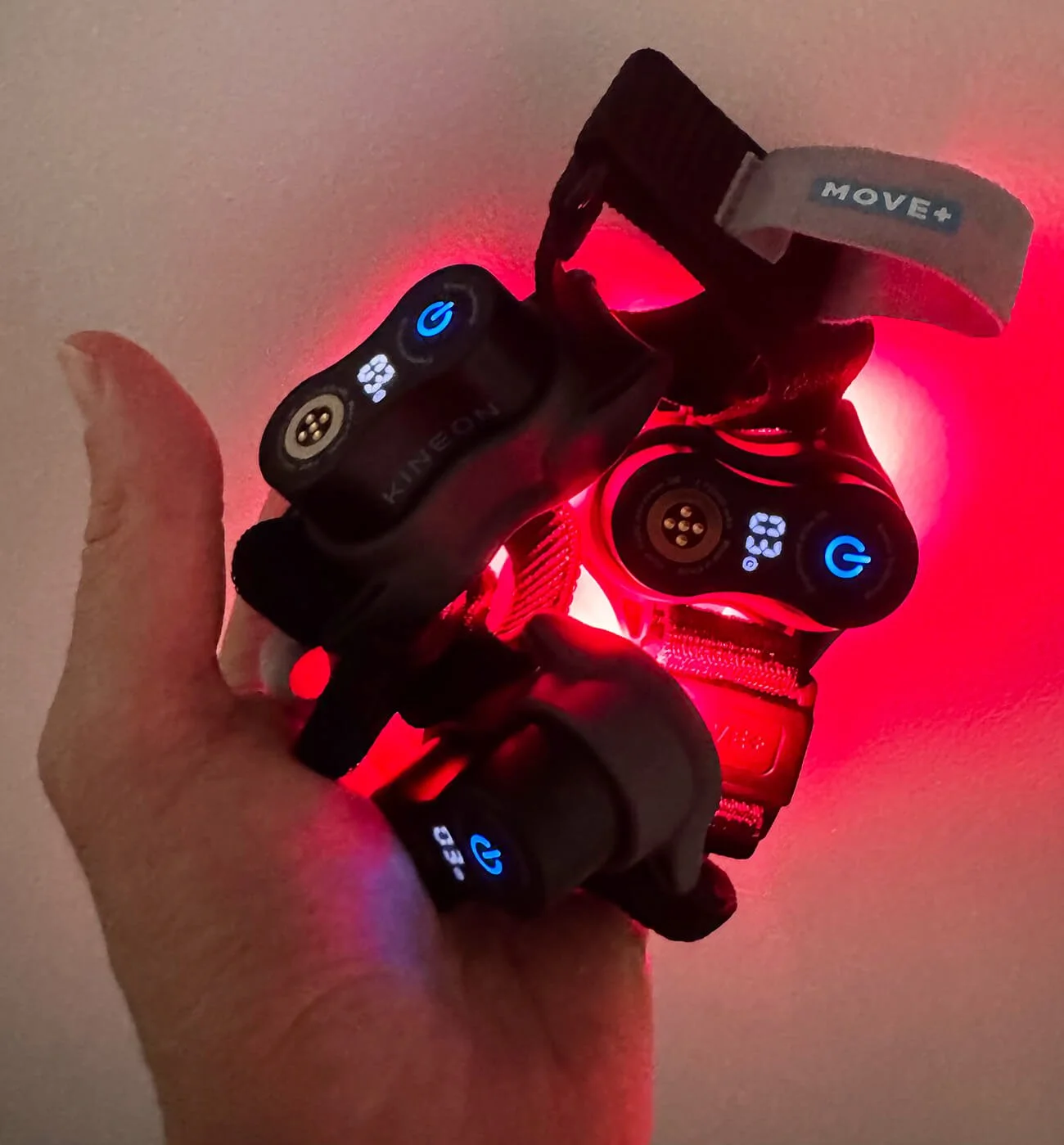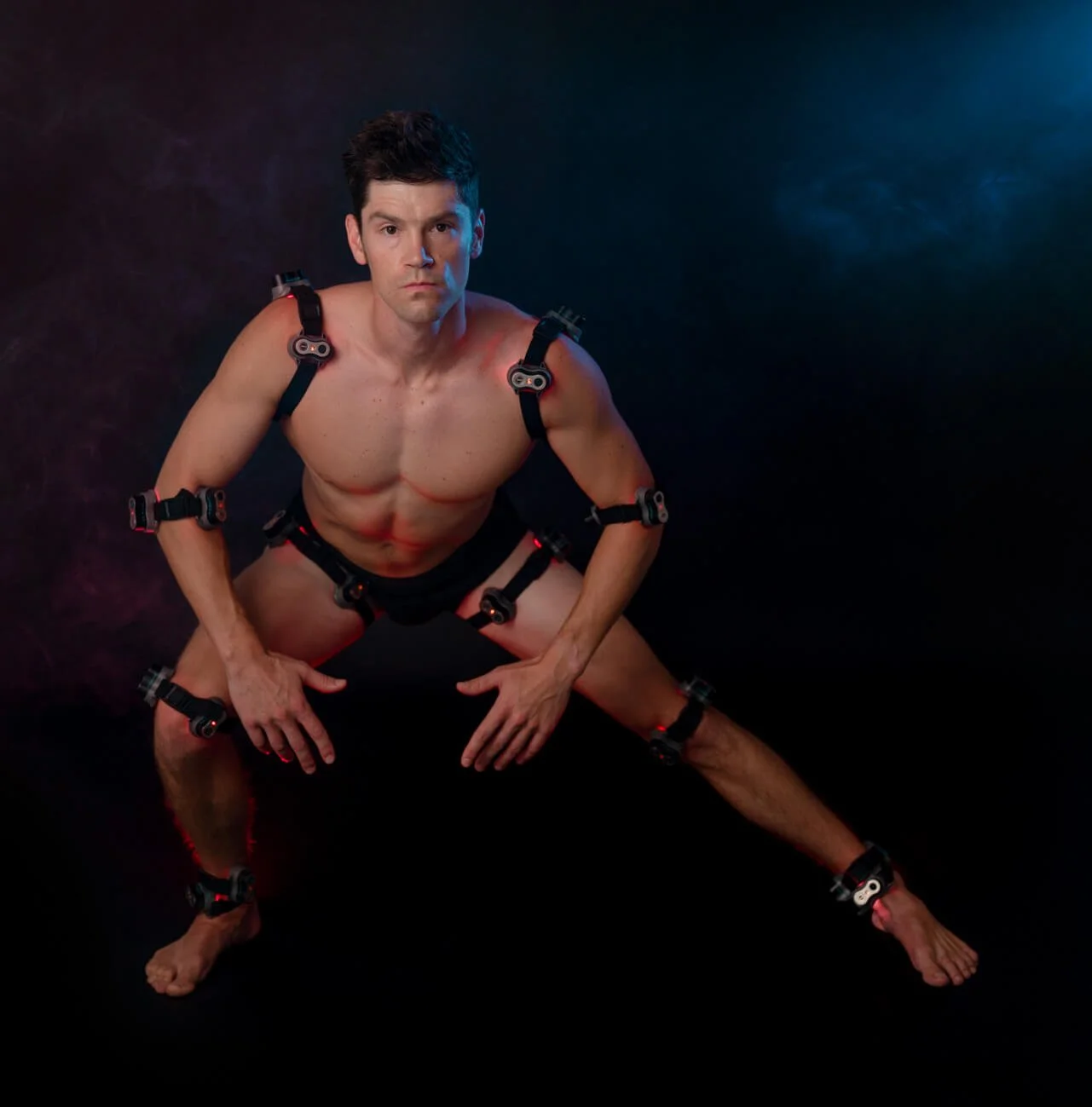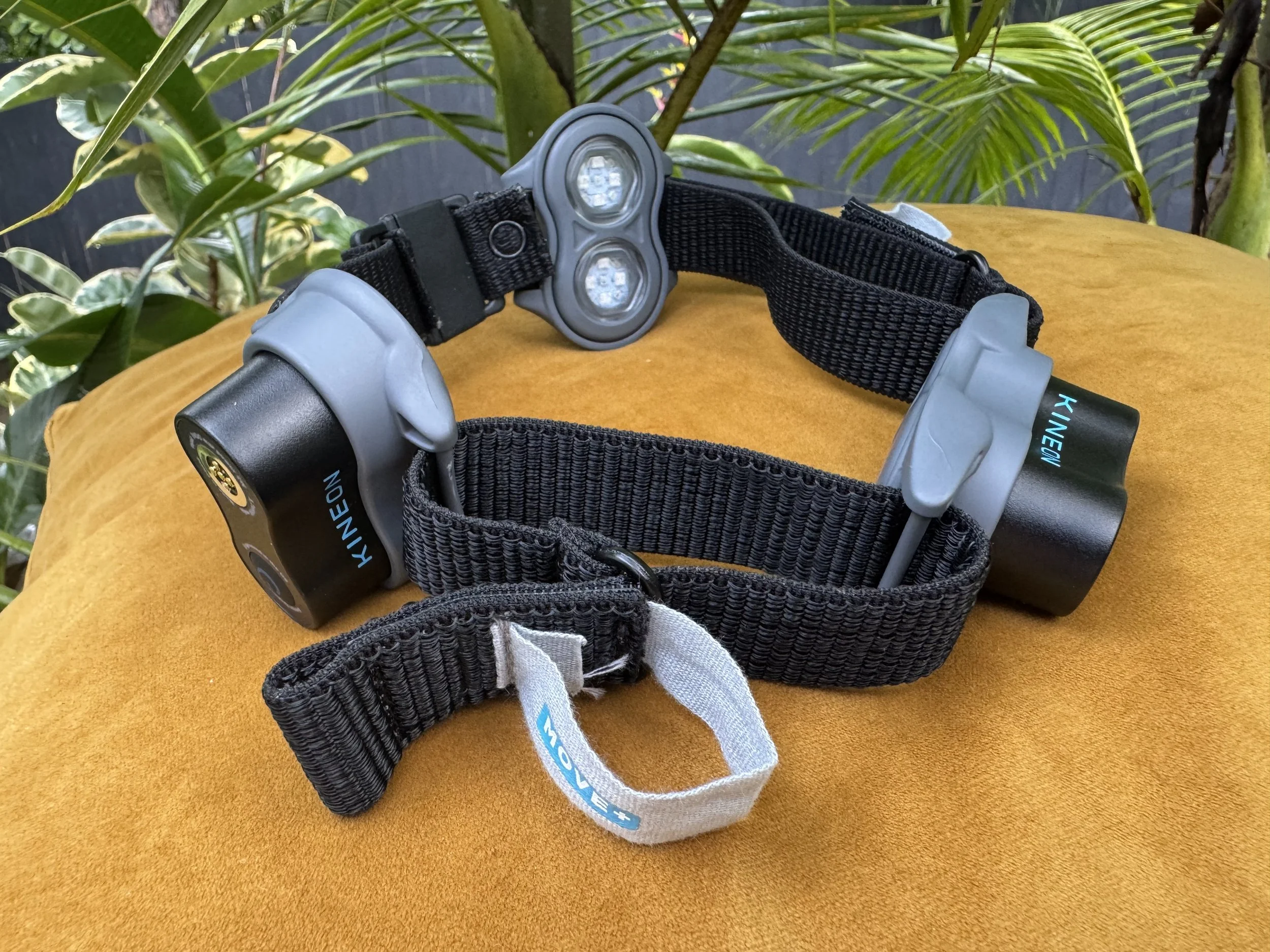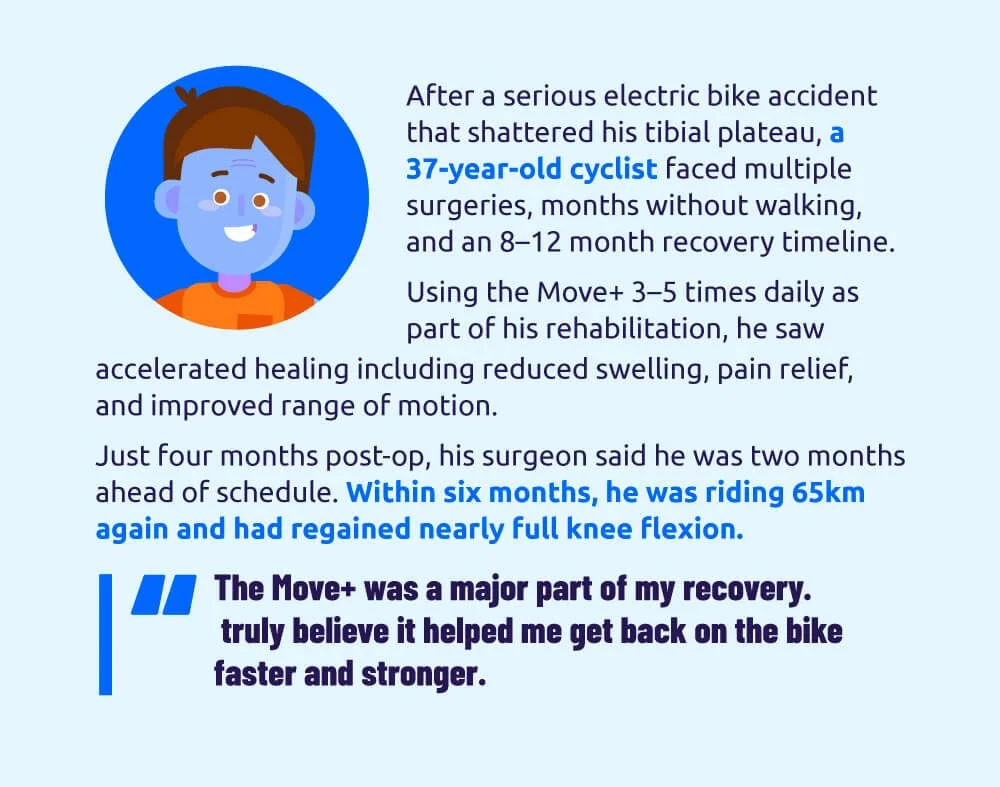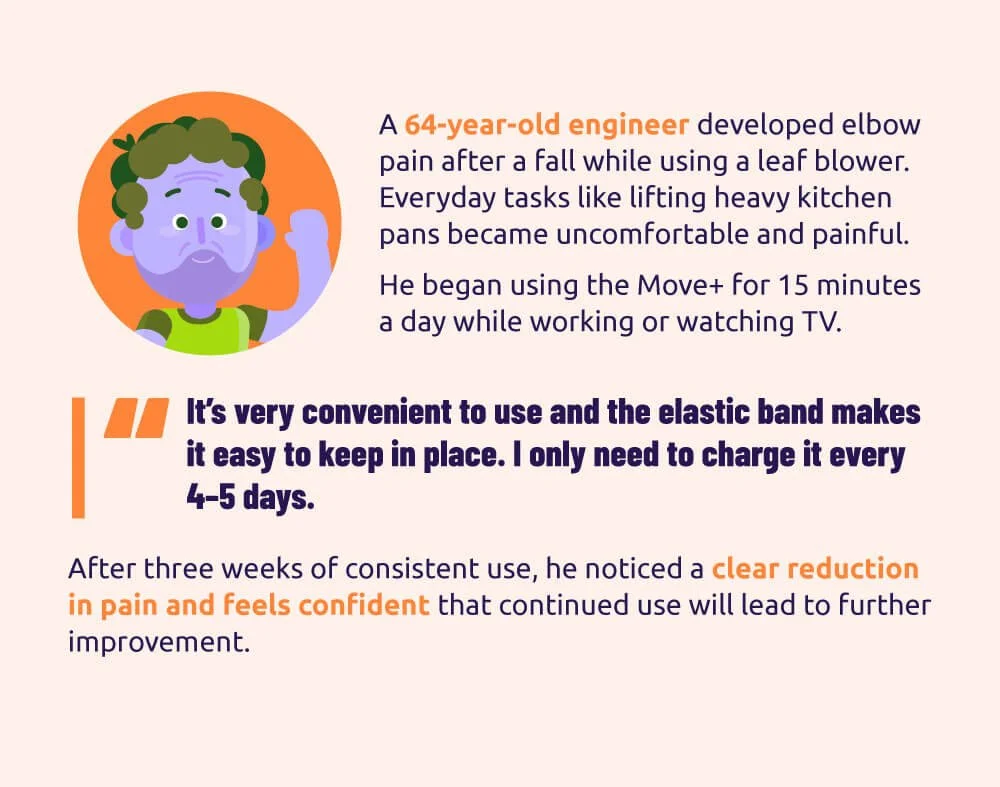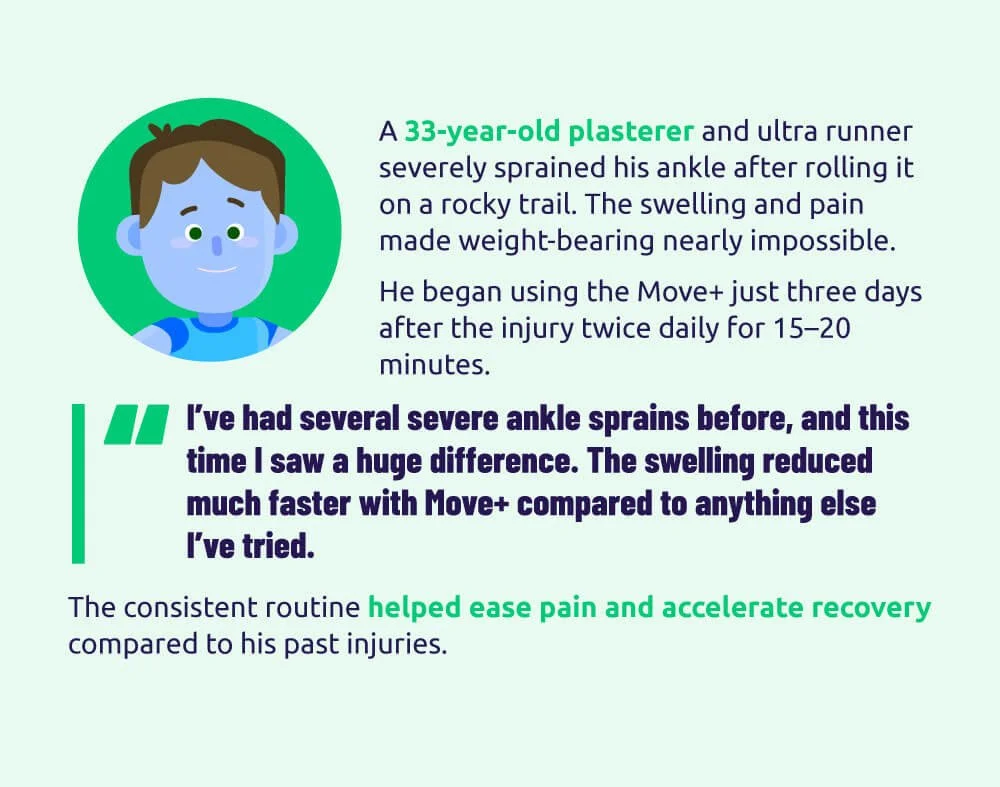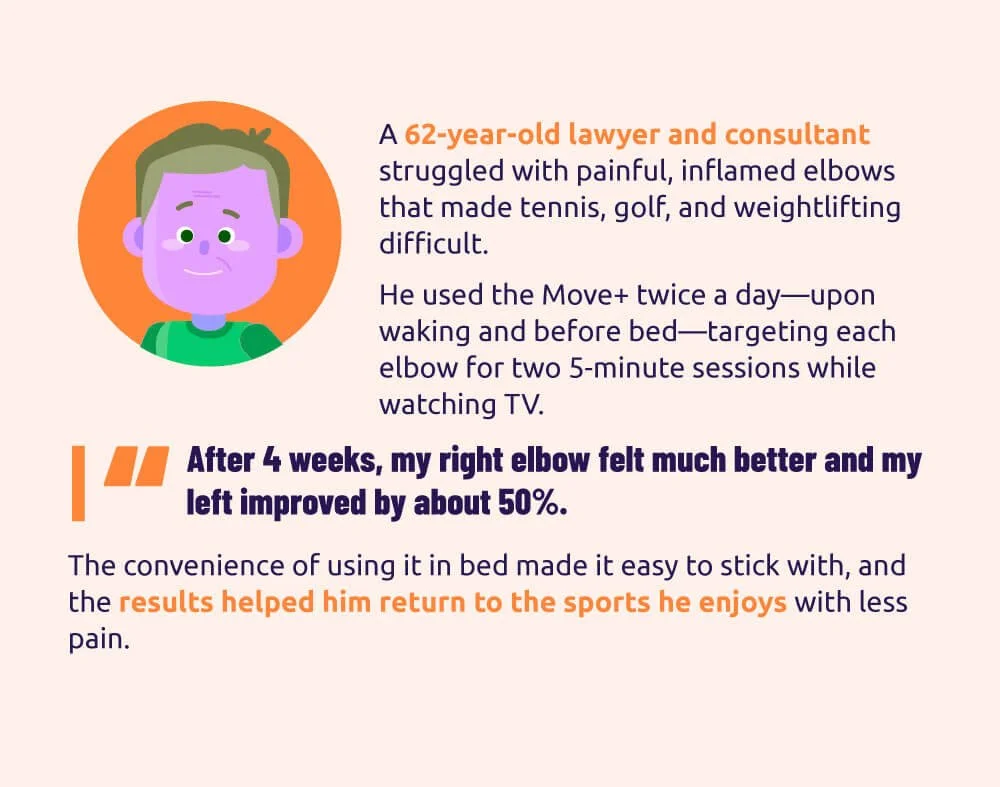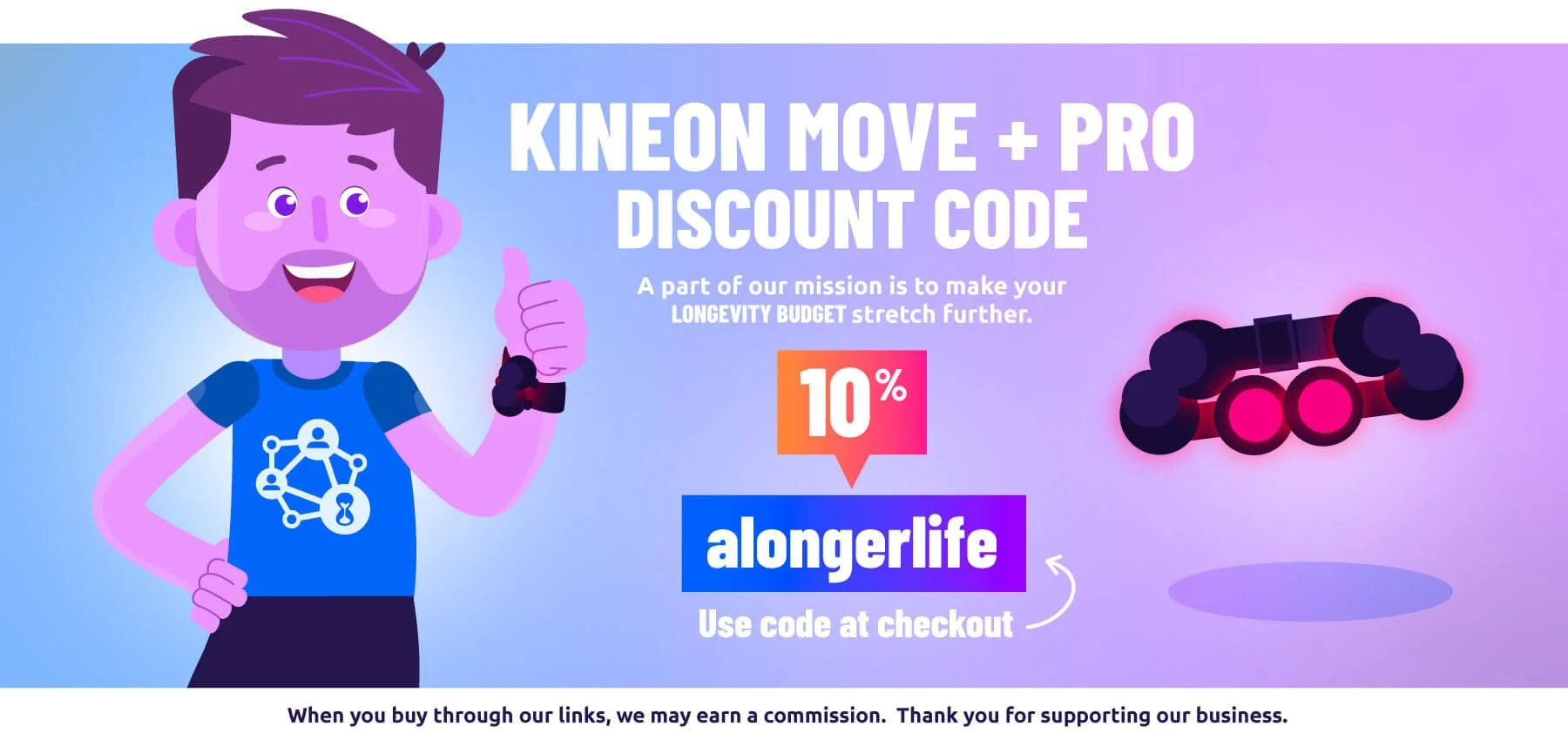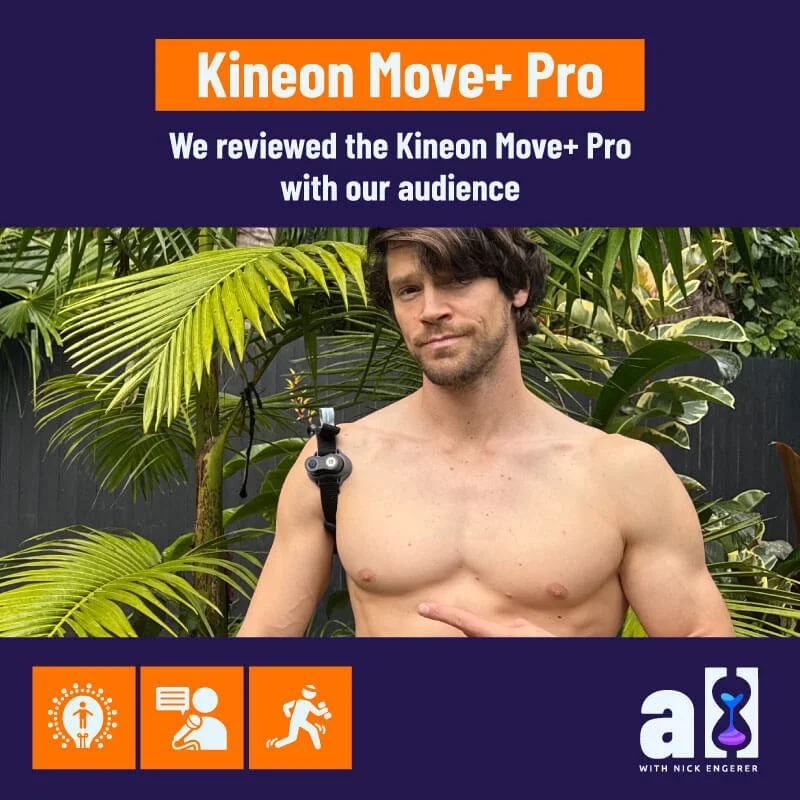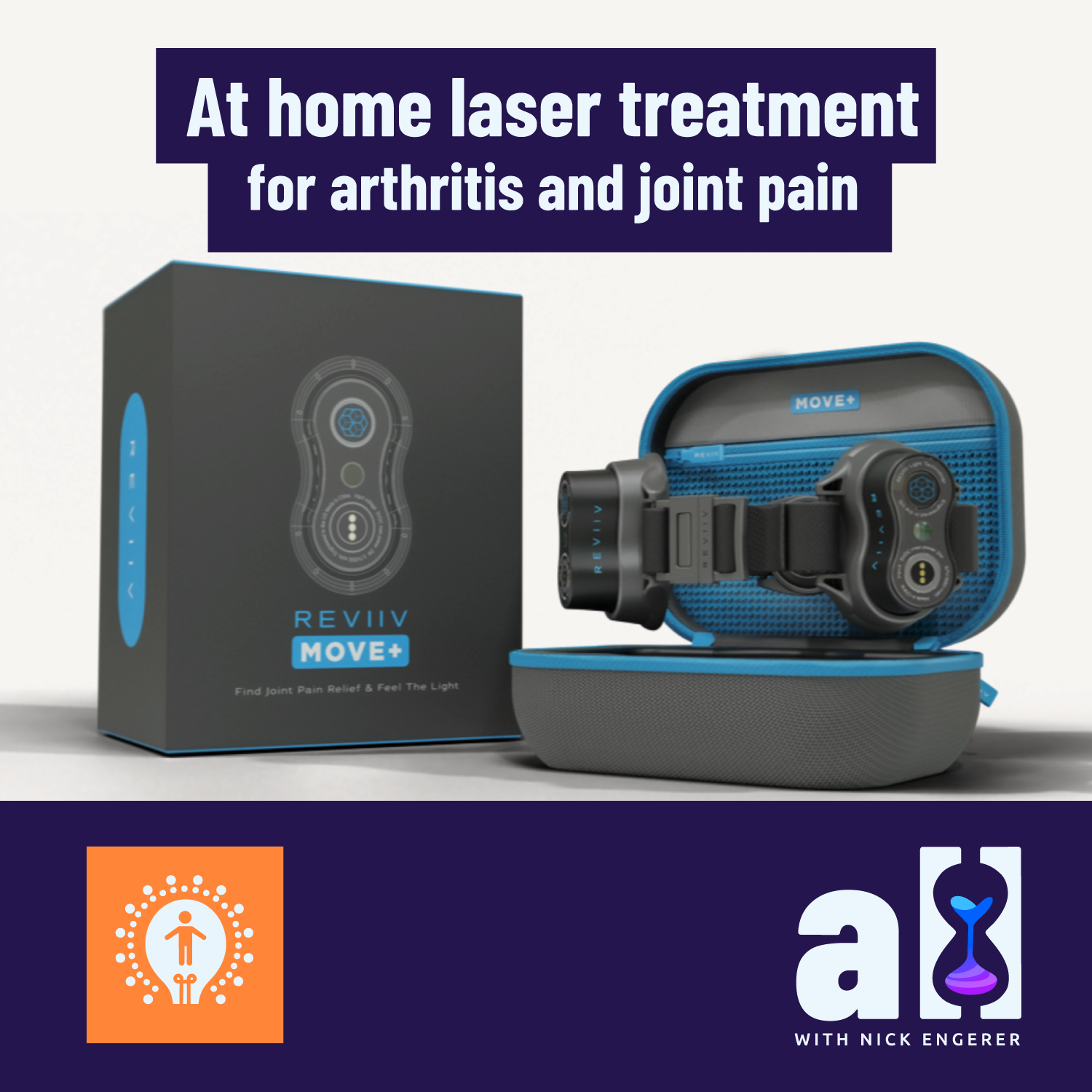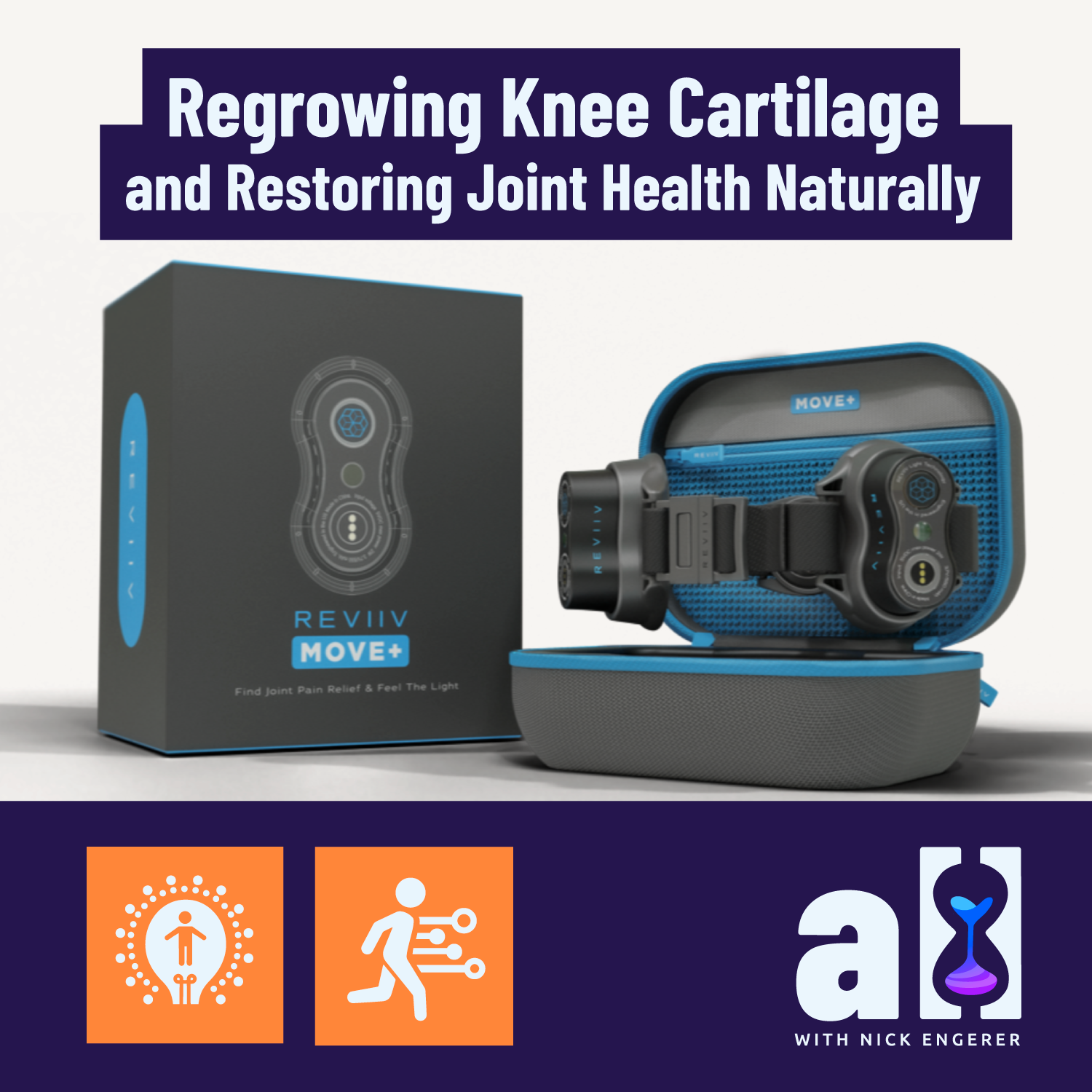Kineon Move+ Pro Review (with A Longer Life Audience Feedback!)
Reviewing the Kineon Move+ Pro
I am very excited to share our Kineon Move+ Pro review as I’ve been an avid supporter of the team at Kineon from their earliest of days. I can pull previous models of the Kineon Move out of my secret stash which are amongst the earliest of their testing models.
Along the way, I’ve had access to most every version of the “Move” that they have created, and I’ve been hands on with each of them for many tens of hours of use.
To say that not every version impressed me would be generous - in particular some of the versions of the strap have been unusable, in my opinion.
Other issues included lights not synchronizing, or synching with the wrong set, quickly declining battery health, to name a few standout frustrations.
But what I love about the team at Kineon, and in particular CEO and Co-Founder Forrest Smith, is they really believe in their mission of helping their customers get out of pain and back into movement.
So when they hear feedback, they keep iterating, keep inventing and keep improving. With the arrival of the Kineon Move+ Pro, they’ve reached peak form and all of my complaints have been addressed.
Look no further than the 1:1 interview linked in this review with Forrest for abundant evidence of the heart in what they do (we even moved him to tears speaking about the Move+ Pro helping desperate people) and our discussion about them being on the 38th iteration of their light based ‘dosing model’ (relentless drive to improve) and them *finally* getting the strap design right (hooray!).
Have Kineon Finally Got It Right with the Move+ Pro? Our Review
In this Kineon Review, we pulled out all the stops. Not only have I gotten hands on with the device and done some advanced testing, but I’ve also collected unique A Longer Life audience feedback on the device. We circulated 10+ Move red light therapy units through a wide range of user types, including professional and amateur athletes, chronic pain sufferers and the 60+ age demographic (think ‘retiree’ with aches and pains). They had all sorts of complaints, ranging from knee pain, to damaged tissue to chronic mystery symptoms.
After using the device for (at least) 30 days, the feedback we gathered was overwhelmingly positive and that’s because *the Kineon Move works* through the well established power of red light. Our audience found that the Kineon device was able to relieve joint pain, reduce inflammation and stimulate healing. With the Kineon Move+ Pro now in well-refined, penultimate form (we are sure further improvements are sure to arrive given their track record), we are confident that you will not only feel the benefits that well targeted red light therapy can offer, but also enjoy the ease of use and reliability you deserve.
The Kineon Move+ Pro Overview
If you’re new to the Kineon Move+ Pro story, you can rest assured that you’re arriving at the perfect time. After shipping 50,000 devices worldwide, the product has now reached a level of maturity that you can be confident in.
In the world of red light therapy, the Kineon Move+ Pro stands out for its innovation and healing potential. From its humble beginnings to its current iteration, this device has transformed the way its users approach pain management and recovery, as Forrest likes to say, the Move+ Pro is a “Non Pharmaceutical Solution” (these are unfortunately at times rare!).
To get started, let’s cover the basics. The Kineon Move+ Pro consists of three light therapy units (called ‘modules’) placed in a highly adjustable strap. The three modules are wireless, removable and rechargeable (lithium Ion battery in each) and come with a carry case that holds a USB-C cable and the charging dock. It is light-weight, highly portable and you can zip up its sturdy case and take it anywhere. On a single charge, you can get up to 4 hours of treatment time (I’ve independently validated this). Each module contains LED light diodes for the red light band and a class 1 laser for the near-infrared light.
Bringing this level of red light therapy out of the office / lab into the home was a key achievement in the Kineon story, as was achieving the relatively affordable price point (from $10k+ ‘sports clinic’ devices down to ~$500). But well beyond these features, the Kineon story of innovation really lies within the ‘dosing’ models, user validation & feedback and their expertise in understanding and engineering light itself.
Next, let’s go deeper on the ‘red light therapy’ behind the Kineon Move+ Pro.
Yours truly wearing 10x Kineon Move’s - a world record
What Sets the Kineon Move+ Pro Apart
Red light therapy isn’t new to the A Longer Life audience. We’ve been covering it for a long time and with good reason. It is simply one of the most effective and science backed longevity technologies (the focus of our brand) available. The entire field of ‘photobiomodulation’ (see our 2022 interview with Forrest for the background) stands out for the depth of science behind it.
What our audience will also understand is that light and radiation are complex and that marketing hype full of branded tech buzzwords and social media influencer ‘reviews’ makes it extremely difficult to know which products are legitimate. The trouble is that many are low quality, overpriced or at worst ineffective (see for example our red light therapy mask review).
Luckily for you, this is exactly where both A Longer Life (this website) and the Kineon Move+ Pro set themselves apart.
We *only* partner with companies that have integrity, have a mission driven to help their customers, have the data to demonstrate their technology actually works and that I have personally tested and validated myself.
Meanwhile, the team at Kineon distinguish themselves with their values/mission and their detailed understanding of the properties of light and how it interacts with biology. Kineon have built specific models which they use to understand the highly complex interactions between light and human tissues. These so-called ‘dosing models’ are necessary for understanding the many different variables involved in delivering light therapy and how to get the light to interact with the ‘photoreceptor’ opportunities in your body.
Reviewing the “Red Light” in the Kineon Move+ Pro
The team at Kineon have had to relentlessly iterate through the many different ‘knobs’ they can turn in the engineering that delivers the light, to get it to activate the ‘correct parts’ of human tissues (there are six unique biological opportunities for light to have positive impact).
This is more than just the wavelengths of light (the Kineon uses 660nm ‘deep red’ and 808nm ‘near infrared’) it also includes the optical power, the ‘fluence’ of the light pulsations and the formation of the light (e.g. LED light vs lasers to achieve the optimal penetration depths).
This stuff is far more complicated than simply shining some red light LEDs into your knee, there is a head-spinning amount of detail at play here, which I cannot afford to go into within this review. But as a radiation scientist in my former life, you can trust me when I say, Kineon not only know what they are talking about when it comes to photobiomodulation, but that there is simply no other device on the market that even comes close to what the Move+ Pro can achieve, and that is because of their detailed attention to these ‘dosing models’.
I use the Kineon Move+ Pro on my knees regularly
Kineon Move+ Pro Useability & Hands On Experience
The Move+ Pro features an upgraded strap system for better comfort and ease of use, the addition of a one-button sync for modules and an upcoming app will provide usage nudges and tracking.
The basics of using the Move+ Pro are very simple. You click the modules into the strap, place them where you are experiencing pain or inflammation, and adjust the strap to hold them in place.
A single click of any of the power buttons will turn on all three lights (synchronization) and the standard treatment time is 10 minutes, which can be adjusted to 5 or 15 minutes.
Personally, when I have an issue I am treating, I’ll use it for 20-30 minutes 2-3 times per day until the issue resolves (more on this in the next section). If you choose to purchase a device, you’ll have 30 days to test it - which is plenty of time to notice any signs that it may relieve joint pain reduce inflammation and stimulate healing for you.
In terms of “where you can use the Kineon Move+ Pro” - the answer is anywhere that you have pain. The device can be used on any joint or soft tissues on the body (we do recommend you don’t use it on or directly next to the eyes), with sessions treating the direct area of pain as well as surrounding regions. On the Kineon website, you can find a wide range of ‘protocols’ for different conditions / areas of the body with a search through their ‘blog’.
The upgraded strap options include 1) the standard strap in the kit and 2) the adjustable strap 2.0. Where previous straps have had a host of issues, I have found the standard included strap, to address them all. The velcro holds tight, button clips have been added where velcro staps didn’t hold enough tension and the strap can suit a wide variety of circumferences (wrists, neck, shoulder, knees, even some quadriceps.
Use on the back or other areas of the trunk won’t flow easily with the standard strap, but modules can be removed from the strap and be laid or held in place while lying down.
Re-charging the modules is incredibly simple, and can be done with the charging dock remaining in the case. The USB-C cable (included) can be run from any standard USB-A charging port, and connect through the case. Charging from completely empty takes approximately 4 hours, and the onboard charge indicators are intuitive and easy to understand.
 |
Does the Kineon Move+ Pro Work? Our Audience’s Surprising Feedback
As far as the ‘why’ behind the Kineon Move+ Pro’s functionality, and how it can improve recovery, reduce pain and heal injuries, we’ll direct you to our detailed 1:1 interview with Forrest from 2021, as the core science remains unchanged.
Let’s instead focus on the most important question of this review: Does the Kineon Move+ Pro work? Does it accomplish what it claims to do? Namely:
Reducing pain (and inflammation)
Improving recovery
Accelerating healing of damaged tissue
Be effective across body parts
We have three sources of information we can look to:
Information provided by Kineon
My personal experience and testimonial
The A Longer Life audience.
Let’s take a look at some key points from all three.
1. Kineon Website
Obviously, like any prudent and experienced customer, you’re going to be a bit skeptical about the claims that a company makes about their products online. Unfortunately, we live in a world where marketing hype too often crowds out reliable information and the drive to sell eclipses integrity.
But let me vouch personally for the team at Kineon and suggest you at least take in the following pieces of information.
1.1k reviews and counting with a 4.8/5 rating (that’s impressive)
149 clinician endorsements on Frontline MD (uncompensated real feedback from actual medical professionals)
Real-world verified customer testimonials from every day people who were so positively impacted in their pain journey, they wanted to help *you*
Read the Kineon website with a fresh eye and an ounce (or two) of trust, and you’ll start to see this whole red light therapy wearable thing might actually work…
2. My Personal Experience
In my experience, the answer to ‘Does the Kineon Move+ Pro actually work?’ is a resounding “Yes!!” with two exclamation points. I have time and time again turned to my Kineon Move (in all versions/formats) to recover from competitions, to treat mild injuries, to support my shingles recovery and even to *heal* a potential stress fracture (diagnosed by multiple medical professionals and then cleared of risk after using the Move. Watch my short video below for the story).
Beyond aches and pains, I use the Kineon Move+ Pro preventatively on both of my knees regularly as a part of my longevity strategy, to help look after the cartilage, ligaments and tendons that I routinely challenge with my longevity fitness regimen. I’ve recently even begun wearing the Kineon Move+ Pro on my neck 15 minutes a day to proactively improve my cardiovascular system health (emerging research is beginning to support this).
Using the Kineon Move+ Pro is so simple, that I just keep it charged up next to my couch or my work desk and place it on whatever area of the body I am treating while I am working or relaxing.
3. The A Longer Life Audience Kineon Reviews
In an ALL first, I made the call to invest in the purchase of 10x Move devices and circulate them into our audience to collect first hand user data ‘in the wild’ well away from any undue influence. Each was given a Kineon Move for a period of 30 to 90 days to test out and asked to keep detailed notes and complete an outgoing survey of their experience.
These audience members varied widely in age, evenly comprised both genders, and represented an array of pain and or movement challenges. This included knee pain, elbow pain, ankle pain and even neck pain. They also represented many different levels of physical activity from professional athletes, to amateur weekend warriors through to the relatively sedentary desk worker.
The feedback we gathered was overwhelmingly positive and further reinforced the experiences and testimonials presented on the Kineon website. If there was any chance they were ‘making stuff up’, they did a great job faking it as it was exactly what we independently verified. Check out what our audience said below…
Hint: Use the < > controls to advance through the Kineon reviews
Kineon Move+ Pro: Frequently Asked Questions (FAQ)
1. How does the Kineon Move+ Pro work to relieve joint pain?
The Move+ Pro delivers photobiomodulation via 660nm red LEDs and 808nm near-infrared lasers, penetrating up to 5–6 cm to stimulate mitochondrial ATP production, enhance blood flow, reduce inflammation, and accelerate tissue repair in joints. Ideal for osteoarthritis, tendonitis, and chronic pain—apply directly to the area for 5–15 minutes daily for optimal results.
2. What makes the Kineon Move+ Pro different from other red light therapy devices?
Unlike LED-only panels with shallow 2 mm penetration, the Move+ Pro combines medical-grade lasers and LEDs for 5–6 cm depth, with dosing models refined over 38 iterations from hundreds of clinical trials. Its wireless, modular design with adjustable straps enables precise, portable targeting on any joint or muscle, far surpassing bulky competitors.
3. How long does it take to see results with the Kineon Move+ Pro?
Many users feel pain relief within 1–4 weeks using 5–15 minutes daily; acute issues may improve in days, while arthritis or chronic conditions often need 2–4 weeks for noticeable mobility gains. Consistency with short daily sessions outperforms longer, infrequent use—track progress with the upcoming app for personalized guidance.
4. Is the Kineon Move+ Pro safe and easy to use?
Yes—FDA-cleared, non-invasive, Class I lasers require no eye protection and have zero reported side effects. Simply clip modules into adjustable straps, select 5/10/15-minute sessions with one-button sync, and treat anywhere; the rechargeable case with USB-C dock keeps it travel-ready and intuitive for all ages.
5. Can the Kineon Move+ Pro help with knee pain?
Absolutely—a 2019 meta-analysis found red light therapy significantly reduces knee osteoarthritis pain and disability vs. placebo, with benefits lasting 1–12 weeks post-treatment. The Move+ Pro uses the same validated 660nm/808nm wavelengths to target inflammation and support joint health with daily 5–15 minute sessions.
6. Does the Kineon Move+ Pro work for arthritis or chronic conditions?
Yes—it excels at relieving arthritis, tendonitis, and chronic joint issues by reducing inflammation, boosting cellular energy (ATP), and triggering natural tissue repair. Thousands of users, including our audience testers, report improved mobility and less pain after 2–4 weeks of consistent 5–15 minute daily use.
7. What is the 30-day free trial policy for the Kineon Move+ Pro?
Kineon offers a risk-free 30-day trial: use the device 3–5 times per week for 5–15 minutes daily over 4 weeks—if no improvement in pain or mobility, receive a full refund or expert guidance. This ensures you can confidently test real-world results on your specific condition before committing.
8. How long should each Kineon Move+ Pro treatment session last?
Recommended sessions are 5–15 minutes daily, tailored to your issue—shorter for mild pain, longer for chronic conditions. Daily consistency yields far better results than sporadic longer treatments; the upcoming app will provide usage tracking and nudges to optimize your routine and outcomes.
9. Is the Kineon Move+ Pro backed by science?
Yes—over 6,000 studies in the past 5 years and hundreds of clinical trials validate photobiomodulation for pain relief, inflammation reduction, and healing. The Move+ Pro uses only the most effective wavelengths, power, and pulsing proven in research, earning endorsements from clinicians and trainers.
10. Can the Kineon Move+ Pro be used for conditions beyond joint pain?
Definitely—it treats muscle fatigue, post-workout recovery, back pain, stiffness, tendonitis, and more across the body. Remove modules for free placement or add extender straps (sold separately) for larger areas like hips or trunk; use preventatively or acutely to enhance movement and longevity.
Kineon Move+ Pro: Further Reading (Scientific Research)
Photobiomodulation and Sports: Results of a Narrative Review
Effect of near-infrared light-emitting diodes on nerve regeneration
In vitro and in vivo optimization of infrared laser treatment for injured peripheral nerves
Photobiomodulation for knee osteoarthritis: a model-based dosimetry study
Low Level Laser Therapy for Patients with Cervical Disk Hernia

